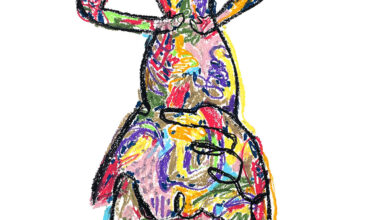The second edition of the “Vestirsi da Uomo” event during the Pitti trade fair in Florence was a theatrically visionary and surreal journey into the world of fashion.
Text by Anna Battista
Among the main shows that took place during the Pitti trade fair last year there was an event entitled “Vestirsi da Uomo” (Dressing Like a Man). This catwalk show curated by Olivier Saillard was conceived as a provocation to show how women can still dress stylishly by taking basic pieces selected from the male wardrobe and wearing them in unusual and versatile ways, turning for example a shirt or a jacket around and using it like a skirt.
The second edition of “Vestirsi da Uomo” event took place last Thursday in Florence and, while in essence the final aim and purpose were the same – showing how traditional and classic pieces can be reinterpreted in radical ways – the staging was completely different.
Curated by Marc Ascoli (famous for his work with Yohji Yamamoto, Jil Sander, Cerruti, Chloé and many more) in collaboration with Linda Loppa, Director of the Florence-based Polimoda fashion school, and Patrick De Muyinck, manager of its Design Department, the event took place in the 19th century Villa Favard (designed by Giuseppe Poggi), current new premises of the Polimoda institute.
Rather than sitting down to a catwalk show, guests were invited to willingly suspend their beliefs at the door and step into a fantastic, yet at times eerily disturbing, world, a crossover between David Lynch”s Rabbits and Inland Empire.
Men-rabbits were indeed one of the leitmotiv of the event: some of them welcomed the visitors at the door, others reappered like mysterious presences inside the villa, walking around a table were the Polimoda students sat with books on their laps playing every now and then a game of musical chairs, or popping out of doors on the first floor of the villa.
Downstairs young models posed behind a framed glass, giving the impression they were a painting in slow yet constant motion or inhabitants of the hidden dimension little Alice found herself in when she stepped through the mirror.
A black widow – impersonated by French Raphaëlle Boitel, more famous for her performances inspired by La Castiglione and Loïe Fuller at Paris” Silencio (though in this case she was a reference to the mysterious Baroness Fiorella Favard of Langlade who originally comissioned the villa to Giuseppe Poggi in 1857) – madly ran around the house or swirled in front of the guests like a whirling dervish, while, animated by the performers of the Compagnia Dromosofista, two jumpers hanging in a wardrobe tenderly caressed each other like lovers (definitely the best and most poetical performance in this salon of curiosities).
The tableaux vivants – recreated by actors, models and students – were alternated with bands such as Belgian Lawrence Wasser and French Omnichord wizard Owlle, playing on the ground and first floor.
Once again the main pieces from the male wardrobe came from various labels – such as Barbour, Cruciani, Borsalino, Herno and Yuketen just to mention a few ones – but this time they were matched with brightly coloured knitted and crocheted patchworked pieces made by the Polimoda students.
As a whole the event was more entertaining than last year”s when the thin line between the surreal and the ridiculous was often overstepped. This time there was definitely a more joyful and exuberantly disturbing mood in the air, indirectly reminding us that fashion is a fairytale story with very dark twists. Yet, while the setting and the staging were surprising for Italian standards, they weren”t maybe that new if seen from a more international and broader perspective.
Indeed the experimental format of the event bore with it strong echoes of other multi-sensory displays suspended between the real and the unreal, the magical and the frightening, such as the Enchanted Palace exhibition at the Kensington Palace, while the emphasis on the anthropomorphic animals and the use of masks seemed to be a mix of visions randomly combined and pasted together from David Lynch”s films, Alice in Wonderland, Madame Schreck”s Museum of Monsters and the multi-layered dream world of the human subconscious, a mix that ultimately proves that, to make contemporary fashion digestible, you often have to turn it into a confusing distortion of reality.
Images by Katsuo Mifreki












